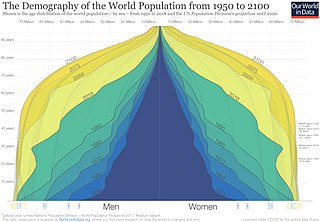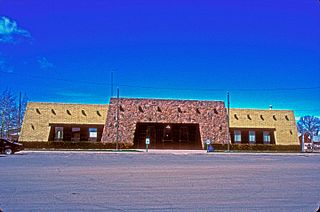Related Research Articles

Genealogy is the study of families, family history, and the tracing of their lineages. Genealogists use oral interviews, historical records, genetic analysis, and other records to obtain information about a family and to demonstrate kinship and pedigrees of its members. The results are often displayed in charts or written as narratives. The field of family history is broader than genealogy, and covers not just lineage but also family and community history and biography.

Demography is the statistical study of human populations: their size, composition, and how they change through the interplay of fertility (births), mortality (deaths), and migration.

Conejos County is a county located in the U.S. state of Colorado. As of the 2020 census, the population was 7,461. The county seat is the unincorporated community of Conejos.

The Society of Genealogists (SoG) is a UK-based educational charity, founded in 1911 to "promote, encourage and foster the study, science and knowledge of genealogy". The Society's Library is the largest specialist genealogical library outside North America. Membership is open to any adult who agrees to abide by the Society's rules and who pays the annual subscription. At the end of 2010, it had 11,014 members.
Prosopography is an investigation of the common characteristics of a group of people, whose individual biographies may be largely untraceable. Research subjects are analysed by means of a collective study of their lives, in multiple career-line analysis. The discipline is considered to be one of the auxiliary sciences of history.
A parish register, alternatively known as a parochial register, is a handwritten volume, normally kept in the parish church of an ecclesiastical parish in which certain details of religious ceremonies marking major events such as baptisms, marriages, and burials are recorded. Along with these events, church goods, the parish's business, and notes on various happenings in the parish may also be recorded. These records exist in England because they were required by law and for the purpose of preventing bigamy and consanguineous marriage.
Civil registration is the system by which a government records the vital events of its citizens and residents. The resulting repository or database has different names in different countries and even in different subnational jurisdictions. It can be called a civil registry, civil register, vital records, and other terms, and the office responsible for receiving the registrations can be called a bureau of vital statistics, registry of vital records and statistics, registrar, registry, register, registry office, or population registry. The primary purpose of civil registration is to create a legal document that can be used to establish and protect the rights of individuals. A secondary purpose is to create a data source for the compilation of vital statistics.
Carey, Cary or Carrey is a surname that has four distinct geographical origins, in order of numeracy: Ireland, the English West Country, Wales and France.

Bradenham is a village and civil parish, a conglomeration of East and West Bradenham, in the English county of Norfolk. It is situated some 5 miles (8.0 km) south-west of the town of East Dereham and 19 miles (31 km) west of the city of Norwich.

Mundford is a village and civil parish in the English county of Norfolk. It is situated at the intersection of two major routes, the A134 Colchester to King's Lynn road and the A1065 Mildenhall to Fakenham road, about 8 miles (13 km) north west of Thetford. The village is 35 miles (56 km) from the city of Norwich and 88 miles (142 km) from London.

A hearth tax was a property tax in certain countries during the medieval and early modern period, levied on each hearth, thus by proxy on wealth. It was calculated based on the number of hearths, or fireplaces, within a municipal area and is considered among the first types of progressive tax.

Hooton is a suburban village and former civil parish on the Wirral Peninsula, within the unitary authority of Cheshire West and Chester and the ceremonial county of Cheshire, England. It was once a separate village but was incorporated into Ellesmere Port as the town expanded outwards during the twentieth century.
Historical demography is the quantitative study of human population in the past. It is concerned with population size, with the three basic components of population change, and with population characteristics related to those components, such as marriage, socioeconomic status, and the configuration of families.

Narford is situated in the Breckland District of Norfolk and covers an area of 970 hectares. Narford village has all but disappeared, with a population of only 41. At the 2011 Census the population of the area remained less than 100 and is included in the civil parish of South Acre.

The history of the family is a branch of social history that concerns the sociocultural evolution of kinship groups from prehistoric to modern times. The family has a universal and basic role in all societies. Research on the history of the family crosses disciplines and cultures, aiming to understand the structure and function of the family from many viewpoints. For example, sociological, ecological or economical perspectives are used to view the interrelationships between the individual, their relatives, and the historical time. The study of family history has shown that family systems are flexible, culturally diverse and adaptive to ecological and economical conditions.

Civil parishes are units of territory in the island of Ireland that have their origins in old Gaelic territorial divisions. They were adopted by the Anglo-Norman Lordship of Ireland and then by the Elizabethan Kingdom of Ireland, and were formalised as land divisions at the time of the Plantations of Ireland. They no longer correspond to the boundaries of Roman Catholic or Church of Ireland parishes, which are generally larger. Their use as administrative units was gradually replaced by Poor Law Divisions in the 19th century, although they were not formally abolished. Today they are still sometimes used for legal purposes, such as to locate property in deeds of property registered between 1833 and 1946.
Colonel Nicholas Gassaway was a colonial military and political leader and justice in early Maryland. He is the progenitor of the some five and a half thousand Americans who bear the family name in the 2000 census.
James Jackson was an Anglican clergyman, best known as the author of an analytical index to the parish register of Brixworth, where he was vicar from 1735 to 1770. His index is one of the earliest complete parish register transcripts and family reconstitution projects.
James Eversfield was an English landowner who served as High Sheriff of Sussex.
Sir Edward Lake, 1st Baronet was an eminent lawyer who became advocate general of Ireland. He was a Royalist, badly wounded in the Battle of Edgehill, and was the first of the Lake baronets. Sir Edward also became chancellor and vicar General of the diocese of Lincoln, England.
References
- Ortsfamilienbücher. In: Wolfgang Ribbe, Eckart Henning: Taschenbuch für Familiengeschichtsforschung. 12th edition. Degener, Neustadt/Aisch 2001, pp. 306–340, ISBN 3-7686-1062-4
- Janet Few, Putting your Ancestors in their Place: a guide to one place studies , Family History Partnership 2014, ISBN 978-1-906280-43-7
- David Hawgood, One-Place Genealogy , Hawgood, 2001 ^